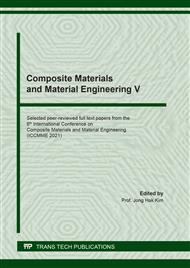p.21
p.27
p.32
p.38
p.44
p.53
p.59
p.65
p.73
The Development of Thermostatically Biodegradable Composite
Abstract:
The purpose of this research is to develop a new type of environmentally friendly container which has thermostatic effect and is biodegradable. This study is based on polylactic acid (PLA) and maleic anhydride grafted polybutylene succinate (MAPBS). Subsequently, the diatomite which adsorbed polyethylene glycol (PEG) was added to prepare a thermostatic biodegradable composite. The addition of MAPBS is to improve the compatibility between PLA and diatomite. In addition, the thermostatic effect, tensile strength, thermal deformation temperature and impact strength of the composite were investigated.
Info:
Periodical:
Pages:
44-49
Citation:
Online since:
June 2021
Keywords:
Price:
Сopyright:
© 2021 Trans Tech Publications Ltd. All Rights Reserved
Share:
Citation:


